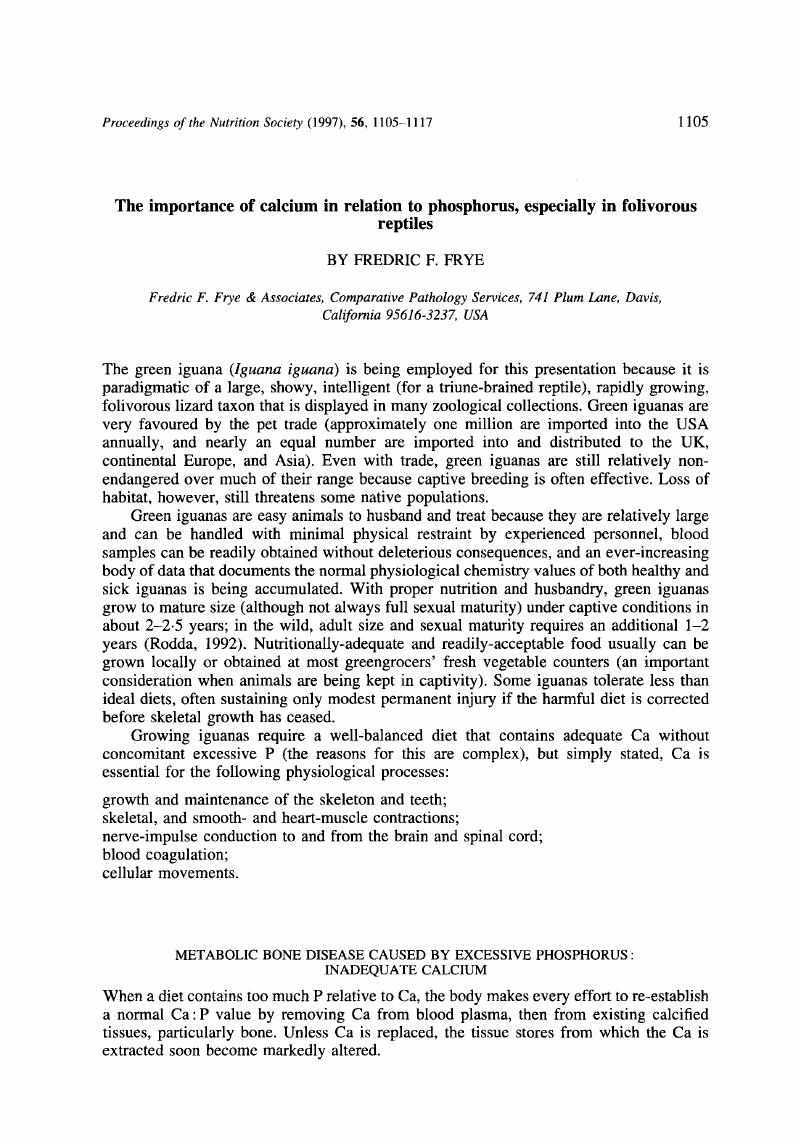Crossref Citations
This article has been cited by the following publications. This list is generated based on data provided by Crossref.
Donoghue, Susan
and
McKeown, Sean
1999.
Nutrition of Captive Reptiles.
Veterinary Clinics of North America: Exotic Animal Practice,
Vol. 2,
Issue. 1,
p.
69.
Zotti, Alessandro
Selleri, Paolo
Carnier, Paolo
Morgante, Massimo
and
Bernardini, Daniele
2004.
Relationship between metabolic bone disease and bone mineral density measured by dual‐energy X‐ray absorptiometry in the green iguana (Iguana iguana).
Veterinary Radiology & Ultrasound,
Vol. 45,
Issue. 1,
p.
10.
Durtsche, Richard D.
2004.
Ontogenetic Variation in Digestion by the Herbivorous Lizard Ctenosaura pectinata.
Physiological and Biochemical Zoology,
Vol. 77,
Issue. 3,
p.
459.
McWILLIAMS, D. A.
2005.
Nutrition research on calcium homeostasis. I. Lizards (with recommendations).
International Zoo Yearbook,
Vol. 39,
Issue. 1,
p.
69.
Burgess, TL
Gartrell, BD
and
Blanchard, B
2009.
A survey of the husbandry of captive tuatara (Sphenodonspp.) in relation to factors implicated in nutritional secondary hyperparathyroidism.
New Zealand Veterinary Journal,
Vol. 57,
Issue. 6,
p.
378.
Moore, Jon A.
and
Dornburg, Alex
2014.
Ingestion of Fossil Seashells, Stones and Small Mammal Bones by Gravid Gopher Tortoises (Gopherus polyphemus) in South Florida.
Bulletin of the Peabody Museum of Natural History,
Vol. 55,
Issue. 1,
p.
55.
Cancelliere, Emma C.
DeAngelis, Nicole
Nkurunungi, John Bosco
Raubenheimer, David
Rothman, Jessica M.
and
Taylor, Andrea B.
2014.
Minerals in the Foods Eaten by Mountain Gorillas (Gorilla beringei).
PLoS ONE,
Vol. 9,
Issue. 11,
p.
e112117.
Michaels, C. J.
Antwis, R. E.
and
Preziosi, R. F.
2015.
Impacts of UVB provision and dietary calcium content on serum vitamin D3, growth rates, skeletal structure and coloration in captive oriental fire‐bellied toads (Bombina orientalis).
Journal of Animal Physiology and Animal Nutrition,
Vol. 99,
Issue. 2,
p.
391.
Pirson, Sylvie
Geerinckx, Lise
Bosseler, Leslie
Simard, Jules
and
Hellebuyck, Tom
2018.
METASTATIC GRANULOSA CELL TUMOR IN A MANGROVE SNAKE ( BOIGA DENDROPHILA MELANOTA ).
Journal of Exotic Pet Medicine,
Vol. 27,
Issue. 3,
p.
6.
Prameswari, Febriana Hawa
Arimbi, Arimbi
Yunita, Maya Nurwartanti
Plumeriastuti, Hani
Yudhana, Aditya
and
Purnama, Muhammad Thohawi Elziyad
2020.
Gambaran Histologi Jaringan Tulang Ekstremitas Biawak Air (Varanus salvator) dengan Metabolic Bone Disease.
Jurnal Medik Veteriner,
Vol. 3,
Issue. 2,
p.
271.
Ardente, Amanda
Toddes, Barbara
and
Schultz, Rhiannon L.
2024.
Nutritional Considerations for Juvenile Exotic Companion Animals.
Veterinary Clinics of North America: Exotic Animal Practice,
Vol. 27,
Issue. 2,
p.
449.



